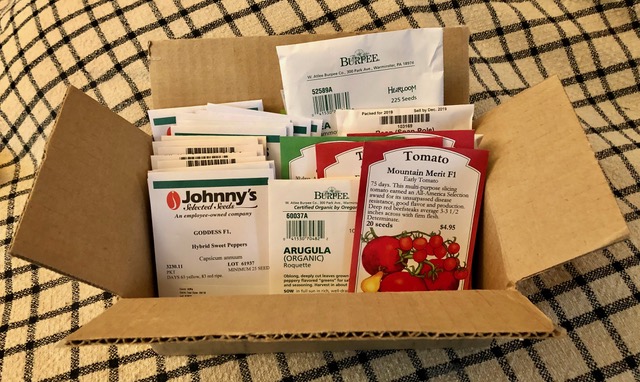By Ginger Dawson
Special to NKyTribune
As you may remember when we met here before, I had received my annual embarrassment of seed catalogues. And, instead of getting down to business and making considered choices of what plants I would be stewarding to their glorious rewards, I got mired down in the silly side-track of eccentric, amusing and just plain weird plant names.
There is enough to consider without this distraction, but I cannot help it. I have always been sensitive to the names of things and the ensuing gestalt—which puts in my head this question: Why on earth did they choose THAT name?

My ‘Little Shop of Horrors’ from a previous year. Consider Audrey II times twenty (Photo provided)
I know this sounds petty and minute (I mean, WHO CARES), but consider this quote written by Mark Twain in a letter to George Bainton, on October 15, 1888: “The difference between the almost right word and the right word is really a large matter—it’s the difference between the lightning bug and the lightning.”
Taking this quote to heart, I was able to feel smugly self-satisfied with my foolish sensitivity, let go of the damn names and move on to the important task at hand.
We take our comfort where we can find it.
Finally, I wrote up my list of what vegetables were going to be planted and then took time to consider my options. This is always fun, and as I have been doing this for a long time, I have gotten better at honing in on what is best for my game.
I always have a single variety of a few vegetables: eggplant, peas, zucchini, okra, beets, parsnips, cabbage, carrots and onions and sometimes a couple of new, experimental choices.
Actually, these new choices are how I’ve learned to garden. I make a pick, do a little research, start the seed and then just sit back and watch what happens. Just about always, the first year raising a new plant ends in near, or complete, failure. In gardening, as in all other facets of my life, I seem to enjoy(?) learning the hard way.
As time has gone on, and perseverance ending with successes, I have expanded into having more than one variety of a few vegetables. This year I’ll try two different types of pole beans, cucumbers, lettuces, radishes and quite a few varieties of sweet and hot peppers.
Of course, I get into tomatoes in a big way. They are THE main event.
Tomatoes are represented by several different types: roma or paste, beefsteaks, slicers and cherries.
I usually select ten different varieties of tomatoes, planning to plant two of each. I then try to break these up into determinate and indeterminate plants.

This year’s seed order waiting to get started.
Indeterminate varieties grow and produce all season until it gets too cold. As an end result, these plants can become enormous and require quite a bit of attention. Pruning and thinning them helps to control blights and the like, and it takes time. With all of the effort I expend on them up to that point, there is no way I’m going to drop the ball. However, I have done just that in the past. Learning the hard way — yep, that’s me. I am consistent.
Determinate plants only produce a few rounds of fruit before they are finished for the season; as a result, they are not nearly as big, have lower yields and do not require pruning. I always plant two or three of these because it gives me a break from the duties of maintaining the others.
Believe me, when you are faced with about twenty tomato plants that have gone “Little Shop of Horrors” on you, you will be glad to forego a few tomatoes that the determinate plants will deprive you of.
When you are planning, it is good to bear in mind how your choices will affect the time and effort it will take. Anything you can do to abbreviate your workload is a good thing.
And also in this line of thinking, there is the matter of hybrid or open-pollinated seed. Heirloom seed is also open-pollinated, with the additional distinction of originating from 50-year, or older, seed stock.
Hybrid plants are a controlled cross of two varieties that have attributes deemed desirable by the breeder. Higher yield, disease resistance, drought and weather tolerance are some of these benefits. On a side note — these are NOT GMO. That’s a whole different can of worms.

This year’s heirloom seduction. Even the name is French. ‘Sprawling indeterminate plants yield a tremendous amount of 1 1/2 pound fruits.’ We’ll see about that.
Since they are a cross, the seed from these plants cannot be depended on to grow true to type the following season. So, seed-saving would not be an option.
Open-pollinated and heirloom plants will grow true to type so that you can save the seed from one year to the next. But, generally there will not be much disease resistance and the yields, for the most part, are smaller.
So, getting back to that issue of planning less work into my game, I just about always plant hybrid tomato seed. Since I have gardened in the same spot for many years, there are more challenges regarding soil or air-borne blights and diseases. If I can find seed that has resistance to these things bred into them, that’s where I’m going.
Now, I do get the romance and allure of heirloom seed (by God, in my mind—right now, I can see an old farmer, surrounded by chickens, singing some Woody Guthrie tune as he hoes a row of beets), so I do succumb to that sentimental urge and end up ordering one packet of heirloom tomato seed. I always regret it because these plants NEVER do as well as the hybrids. They always serve as my reminder to try to resist this romantic notion next year. It seems I always succumb, and am betrayed by the aggravating visit of blight and fewer tomatoes. I blame it on romance. Once a fool, always a fool.
Apparently doomed to continue learning everything the hard way, I turn again to a Mark Twain quote for justification of this sad path:
“Supposing is good, but finding out is better.”
We take our comfort where we can find it.
Ginger Dawson has resided in Covington, Kentucky since 1988. Raised on a farm in South Central Ohio, she has enjoyed a very eclectic and enriching life. She loves her Italianate Victorian Townhouse and particularly the garden behind it. See her new website at intrepidurbanfarmer.com


























Great article Ginger. Am looking forward to future tidbits of great information.
Thanks John!